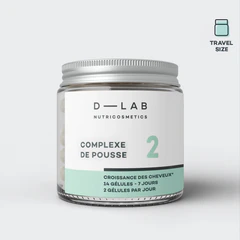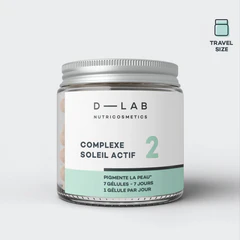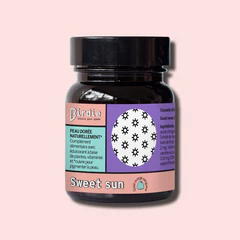Over time, our joints - those precious mechanisms that ensure our mobility - often begin to show signs of wear and tear. In this complex ballet of tendons, ligaments and bones, one player plays an essential role: collagen. This protein, the most abundant in our body, is at the heart of the joint aging process. But how does collagen influence the health of our joints? In this article, we'll look at how to preserve the youthful vitality of our joints.
Découvrir la gamme de suppléments en collagène de D-LAB.
I. Lien entre vieillissement, articulations et collagène
1. Comprendre le processus naturel de vieillissement des articulations.
Le vieillissement est un processus inévitable que chacun d'entre nous traverse, et il n'épargne pas nos articulations. Avec le temps, nos articulations, tout comme d'autres parties de notre corps, commencent à montrer des signes d'usure.
Ce processus débute généralement par une diminution progressive de l'épaisseur et de l'élasticité du cartilage, cette couche protectrice qui permet aux os de bouger en douceur les uns contre les autres.
À mesure que ce cartilage s'amenuise, il devient moins capable d'absorber les chocs, ce qui peut entraîner des douleurs et une mobilité réduite. Parallèlement, la production de liquide synovial, le lubrifiant naturel des articulations, peut également diminuer avec l'âge, contribuant à une sensation de raideur.
Enfin, des facteurs tels que la génétique, le poids, l'usure cumulative due à des années d'activité, et même des blessures antérieures, peuvent tous accentuer le vieillissement de nos articulations. Il est donc essentiel de comprendre ce processus naturel pour mieux prévenir et gérer les désagréments qui y sont associés.

2. Pourquoi le collagène diminue-t-il avec l'âge ?
Collagen is an essential protein found in skin, bone, tendons, ligaments and many other body tissues. It plays a crucial role in maintaining skin elasticity and firmness, as well as the resilience of bones and joints. However, as we age, our body's natural production of collagen begins to decline. Several factors contribute to this decline. Firstly, as we age, fibroblasts, the cells responsible for collagen production, become less active and produce less of this essential protein .
Secondly, environmental factors such as prolonged sun exposure, pollution and smoking can accelerate collagen degradation. Finally, over time, there is an increase in the activity of enzymes, such as matrix metalloproteinases, which break down collagen. All these elements combine to lead to a reduction in collagen in the skin and other tissues, leading to visible signs of aging such as wrinkles, sagging skin and fragile joints.
II. Conséquences d'un déficit en collagène
As a major component of the body's connective tissues, collagen plays a vital role in maintaining the structure and function of many organs and tissues.
Un déficit en collagène peut donc avoir des conséquences profondes et variées sur la santé et l'apparence physique. Sur le plan esthétique, une réduction du collagène dans la peau entraîne une perte d'élasticité et de fermeté, ce qui peut se manifester par des rides, un relâchement cutané et une peau plus fine.
Outre les manifestations cutanées, un déficit en collagène peut affaiblir les ongles et les cheveux, les rendant cassants. Sur le plan fonctionnel, les articulations peuvent devenir plus fragiles, augmentant le risque d'arthrose. Tendons and ligaments, which also contain collagenThis can lead to a loss of strength, increasing the risk of injury. In bones, a reduction in collagen can compromise bone densityThis increases the risk of osteoporosis. In addition, other tissues such as blood vessels, corneas and even the digestive systemwhere collagen is essential to their integrity, can be affected.

1. Les signes d’une carence en collagène :
Collagen deficiency doesn't usually go unnoticed, as it manifests itself in a series of visible and felt signs that impact various aspects of our physical well-being. The first indicator often noticed is the appearance of wrinkles and fine lines on the skin, particularly on the face, neck and hands. The skin also loses elasticity, becoming thinner and drier. Another common sign is a reduction in hair thickness and vigour, and nails that become brittle and fragile. Beyond these external manifestations, collagen deficiency can also lead to joint pain, as collagen is essential for the cartilage that protects our joints. People with a deficiency may therefore experience increased stiffness or pain after physical activity. Loss of muscle mass is also possible, as collagen plays a role in maintaining muscle strength and structure. In addition, some may notice slower healing of wounds or bruising that appears more easily. Overall, these signs reflect collagen's central role in maintaining the health and vitality of many bodily systems.
III. Les Secrets pour Préserver ses Articulations

1. Grâce à l’alimentation :
Diet plays a crucial role in the health of our joints, the complex structures that connect our bones and enable our mobility. By adopting a balanced diet rich in specific nutrients, it is possible to prevent or slow down joint wear and reduce the symptoms of disorders such as osteoarthritis. First of all, omega-3s, found in oily fish such as salmon, trout and mackerel, have anti-inflammatory properties that can help reduce joint inflammation. Antioxidants such as vitamin C, vitamin E and beta-carotene, found in a variety of colorful fruits and vegetables, protect joints from free radical damage. Collagen, found in bone broth or specific dietary supplements, can directly support healthy cartilage. Foods rich in calcium and vitamin D, such as dairy products and green leafy vegetables, are essential for the health of the bones that surround and support the joints. In addition, foods such as garlic, ginger and turmeric have also shown beneficial properties for joint health thanks to their anti-inflammatory compounds.
2. Exercice :
Far from being an enemy of joints, exercise is actually one of their best allies. Regular, appropriate exercise not only strengthens the muscles surrounding the joints, providing better support, but also helps to maintain joint flexibility and stimulate the production of synovium, a fluid that acts as a natural lubricant.

Starting with gentle stretching on a daily basis can improve range of motion and prevent stiffness.Walking, as a weight-bearing exercise, is beneficial for bone density and exerts a moderate impact on joints, which is ideal for their health. Aquatic exercise, such as swimming or water aerobics, offers the advantage of a low-impact environment that reduces pressure on joints while providing gentle resistance to strengthen muscles. Cycling, whether stationary or traditional, also moves the joints without subjecting them to harsh impact. In addition, it's essential to incorporate strengthening exercises, such as those with elastic bands or light weights, to fortify the muscles that support and stabilize the joints.
However, it's important to listen to your body: if you feel pain or discomfort, adjust your activity or consult a health professional.
By making exercise a regular part of our routine, we not only promote our body's overall health, but also provide our joints with the best defense against ailments and the wear and tear of time.
3. Quel collagène pour mes articulations ?
Au fur et à mesure que nous vieillissons, nos articulations subissent un stress naturel qui peut engendrer une usure et une diminution de leur fonctionnalité. Dans ce contexte, l'apport nutritionnel joue un rôle central pour soutenir et préserver leur santé. Si une alimentation équilibrée est fondamentale, tous les nutriments nécessaires ne sont pas toujours obtenus en quantités suffisantes à travers le régime alimentaire seul. C'est là qu'interviennent les compléments alimentaires D-LAB NUTRICOSMETICS. Riches en nutriments ciblés, ils offrent un soutien précieux.
For example, supplements based on hydrolyzed collagen are reputed to help renew collagen in joints.
The Pro-Collagen Suppleness is enriched with active ingredients for the overall maintenance of joints and bones, enabling muscles to function properly. Its action is perfect for those wishing to improve their performance as a complement to a sporting activity, as well as in recovery following an injury or tear.
Type I and III collagen oligopeptides have a global action on skin, tendons and ligaments, as well as on muscles and blood vessels. Easily digestible and combined with vitamin C, they further stimulate collagen synthesis in these different areas of the body.
The combination of patented* verbena, silica-titrated horsetail, blackcurrant and MSM soothes aches and pains and promotes whole-body mobility.
Other supplements, such as those based onOmega-3 as our Pure Omega-3 also have recognized anti-inflammatory properties, which can ease joint pain and improve mobility.
In short, incorporating the right food supplements into your routine can be a proactive strategy to combat aging joints.
To conclude
En conclusion, la préservation de la jeunesse articulaire nécessite une compréhension approfondie du rôle central du collagène dans le vieillissement des articulations.
La diminution naturelle de cette protéine essentielle contribue aux signes visibles de vieillissement. Les conséquences d'un déficit en collagène vont au-delà de l'esthétique, affectant la fonctionnalité des organes et tissus.
La détection des signes de carence, tels que les rides, les douleurs articulaires et leur fragilité, est cruciale. Les moyens de préserver les articulations comprennent une alimentation équilibrée, l'exercice régulier et l'utilisation de compléments alimentaires beauté ciblés, tels que ceux de D-LAB NUTRICOSMETICSrich in hydrolyzed collagen and other essential nutrients.
Adopting these proactive strategies offers an effective defense against age-related joint disorders.







